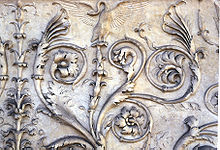Building projects

Close up on the sculpted detail of the
Ara Pacis (Altar of Peace), 13 BC to 9 BC
On his deathbed, Augustus boasted "I found Rome of bricks; I leave it to you of marble". Although there is some truth in the literal meaning of this,
Cassius Dio asserts that it was a metaphor for the Empire's strength.
Marble could be found in buildings of Rome before Augustus, but it was not extensively used as a building material until the reign of Augustus.
Although this did not apply to the
Subura slums, which were still as rickety and fire-prone as ever, he did leave a mark on the monumental topography of the centre and of the
Campus Martius, with the
Ara Pacis (Altar of Peace) and monumental sundial, whose central
gnomon was an
obelisk taken from Egypt.
The
relief sculptures decorating the Ara Pacis visually augmented the written record of Augustus' triumphs in the
Res Gestae.
Its reliefs depicted the imperial pageants of the
praetorians, the Vestals, and the citizenry of Rome.
He also built the
Temple of Caesar, the
Baths of Agrippa, and the
Forum of Augustus with its
Temple of Mars Ultor. Other projects were either encouraged by him, such as the
Theatre of Balbus, and Agrippa's construction of the
Pantheon, or funded by him in the name of others, often relations (e.g.
Portico of Octavia,
Theatre of Marcellus). Even his
Mausoleum of Augustus was built before his death to house members of his family.
To celebrate his victory at the Battle of Actium, the
Arch of Augustus was built in 29 BC near the entrance of the
Temple of Castor and Pollux, and widened in 19 BC to include a triple-arch design.
There are also many buildings outside of the city of Rome that bear Augustus' name and legacy, such as the
Theatre of Merida in modern Spain, the
Maison Carrée built at
Nîmes in today's southern France, as well as the
Trophy of Augustus at
La Turbie, located near
Monaco.

The Temple of Augustus and Livia in
Vienne, late 1st century BC
After the death of Agrippa in 12 BC, a solution had to be found in maintaining Rome's water supply system. This came about because it was overseen by Agrippa when he served as aedile, and was even funded by him afterwards when he was a private citizen paying at his own expense.
In that year, Augustus arranged a system where the Senate designated three of its members as prime commissioners in charge of the water supply and to ensure that Rome's aqueducts did not fall into disrepair.
In the late Augustan era, the commission of five senators called the
curatores locorum publicorum iudicandorum (translated as "Supervisors of Public Property") was put in charge of maintaining public buildings and temples of the state cult.
Augustus created the senatorial group of the
curatores viarum (translated as "Supervisors for Roads") for the upkeep of roads; this senatorial commission worked with local officials and contractors to organize regular repairs.
The
Corinthian order of architectural style originating from ancient Greece was the dominant architectural style in the age of Augustus and the imperial phase of Rome.
Suetonius once commented that Rome was unworthy of its status as an imperial capital, yet Augustus and Agrippa set out to dismantle this sentiment by transforming the appearance of Rome upon the classical Greek model


0 comments:
Post a Comment